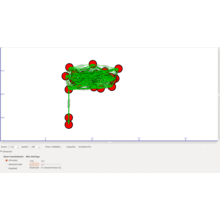Network Simulator Tools
In general, the network simulator is considered as the demonstration of the network characteristics along with its components and the emulators are deployed as the characteristics of network for the replacement of its functions and the network simulators are divided into two types and they are open source and commercial functions. The J-Sim, SSFNet, OMNeT++, Ns2 and Ns3 are based on the open source network simulators and the QualNet and OPNET are considered as the commercial network simulators.
Major Advantages of Network Simulator Tools
Hereby, our experienced research professionals have enlisted the substantial advantages of network simulator tools.
- The network simulator tools are assistive for the users with the expansion of network in real time and it is useful to test the novel technologies and network protocols
- Network simulators are deployed through people with various areas with the utilization of several protocols such as
- Quality assurance
- Analyze
- Verify
- Simulate
- Design
- Industrial developers
- Academic researchers
- Computer simulation is utilized to assist the process of modeling and analysis in several natural systems and the computer assisted simulation technologies are functioning for the simulation networking algorithms systems through software engineering
Topical Applications in Network Simulator Tools
Generally, research scholars have to know all the fundamentals based on network simulator tools. Thus, we have highlighted some of the applications in real time based on network simulator tools in the following.
- Energy efficiency applications in mobile systems
- Structural designs of mobile applications are studied through the energy consumption and it is considered as the originations of processing and rendering tasks with the requirements with high computational complexity that are enhanced for the energy consumption. In addition, various techniques are enhanced with the levels of operating and hardware systems for the development of energy efficiency in mobile devices. This process includes some approaches such as
- Graphical user interface design
- Mobile computation offloading
- Novel applications of wireless signals
- The process of telecommunication and data transmission without wires are described as the term wireless. Consequently, it is described as the process of data transfer among the electromagnetic waves and some wires are used to carry the signals through the parts of the path based on data communication
Intergrated Tools in Network Simulator Tools
Our research experts in network simulation have years of experience in this research field and we have completed several research projects along with the customers satisfaction. The following is about the required integrated tools based on network simulator process.
- JiST
- JiST is considered as the high performance for the discrete event simulation engine for the functions of the standard virtual machine and it is denoted as the prototype of the functions of approaches to create the discrete event simulator and that is denoted as the virtual machine based simulation. It is the amalgamation of both the language based simulator designs and the traditional systems
List of Network Simulator Tools
In general, there are some requirements which are important for the implementation of research projects. Here, we have highlighted the significant list of network simulator tools in the following along with its specifications.
- QualNet
- Ns 2.35
- SSFNet
QualNet
QualNet is denoted as the testing simulation tool and that is acting as the tool for the processes such as training, testing and planning. In addition, it imitates the characteristics of physical communication network. In addition, we have listed out the libraries based on the components models in QualNet platform in the following.
- Wireless model library
- Developer model library
- Multimedia and enterprise model library
Consequently, our research professionals have listed out the options that are available in the libraries of QualNet platform.
- Urban propagation model library
- Underwater communication networks model library
- Military radios library
- UMTS model library
- Sensor networks model library
- TIREM propagation library
- LTE model library
- Federation interfaces library
- Cellular model library
- Advanced wireless model library
The models based on the functions of virtual world in the QualNet network simulation platform are highlighted in the following.
- It is assistive for the process of KATECH investigation to solve several issues based on vehicle communication development along with the network tools in computer network models
- It is deployed to create the simulation modeling, capabilities of analysis and scalability for various vehicles
- The process of packet sniffing includes the Wireshark to check the interoperability and performance
- It is denoted as the provision of simulation models in the communication through wireless access in vehicular environment
Ns 2.35
In general, Ns2 is providing simulation process for the multicast and routing protocols in both the wireless and wired networks and it is qualified through general public license. Ns2 is the discrete event driven simulator and object oriented which is written in Otcl and C++. The TCL simulation script is considered as the configuration file of Ns2 and it includes the data about the simulation such as
- Setup link
- Topology creation
- Node creation
- Protocols and traffic type
- Number of nodes
- Propagation type
- Antenna type
Procedure to Create Sample Simulation Using Ns2
- Step 1
- Start the process
- Step 2
- Ns simulator object is created and started to design the provided simulation
- Step 3
- The nam file and trace file have to open with the write mode
- Step 4
- Nodes of simulation are created through the set command
- Step 5
- Links are created for the appropriate nodes through $ns duplex link command
- Step 6
- Node orientation is all set for the simulation through orient command
- Step 7
- TCP agent is created for the nodes and attach the agents
- Step 8
- Node1 is configured as sink
- Step 9
- Connect command is used to connect the node0 and node1
- Step 10
- Simulation is scheduled for the calculated time
SSFNet
Scalable simulation framework network models are abbreviated as the SSFNet and it is one of the significant network simulation tools which are deployed with the open source software in several applications in network simulation. The tool is designed based on the expansion of networks such as
- Traffic
- Protocols
- Topology
In addition, it is supportive for the simulation of large scale network including the internet. The SSFNet is considered as the collection of open source Java models of protocols, assorted support classes and network elements based on SSF as the multi domain internet modeling, realistic multi-protocol and simulation. Let us have a look at the network components in SSFNet.
- Network routing behavior using SSFNet
- Simulator API
- SSF standard
- Simulator implementations
- Raceway
- CSSF
- DaSSF
- Network components as Java classes
- SSFNet
- Model instances
- DML configurations
- Simulation model parameters
- Random number seed index
- Limiting
- Continuous rate
- Jitter
- Withdrawal rate limiting
- Sender side loop detection
- Link delay
- Min and max processing times
- Limiting interval
- Rate
- Size
- Simulation application in SSFNet
- BGP route flap dampening
- IPsec and MPLS
- SNMP
- NFS client and server
- Protocols
- Widgets
- FTP and HTTP clients
- OSPF
- Two versions
- Sockets
- UDP
- TCP
- Validated
- IP
- Simplified
- Logical containers
- Protocol graph
- Net
- Physical entities
- Host
- Link
- Router
So far, we have discussed the simulation tools and its significance about the network simulator. In the following, our research experts have highlighted the significant research topics what they have implemented recently using the network simulator tools for your reference. If you have any requests, you can contact our research team. Now, let us discuss about the research topics based on network simulator tools.
Project Topics in Network Simulator Tools
- Hierarchical anomaly based detection of distributed DNS attacks on enterprise networks
- Fog layer based DDoS attack detection approach for internet of things (IoTs) devices
- Detection of Distributed denial of service attacks in SDN using machine learning techniques
- Machine learning approaches for combating distributed denial of service attacks in modern networking environments
- Intrusion measurement and detection in LAN using protocol wise associative memory
To this end, we ensure that we have provided appropriate guidance for the implementation of network simulator tools with realistic applications for the research performance along with the significant tools list. Our technical professionals help you in all the aspects of research such as identification and investigation of new algorithms, approaches, architecture design and so on. For more enquires you can contact us and we are provide 24 x 7 service for the research scholars all over the world. In addition, we assist the research scholars from selecting a topic until the paper publication with in short period of time and our clients endorse about the plagiarism free research work from our research experts.

 Click Here to watch our latest output video using NS3 simulator
Click Here to watch our latest output video using NS3 simulator  Click Here to watch our latest projects screenshots using NS3 simulator
Click Here to watch our latest projects screenshots using NS3 simulator